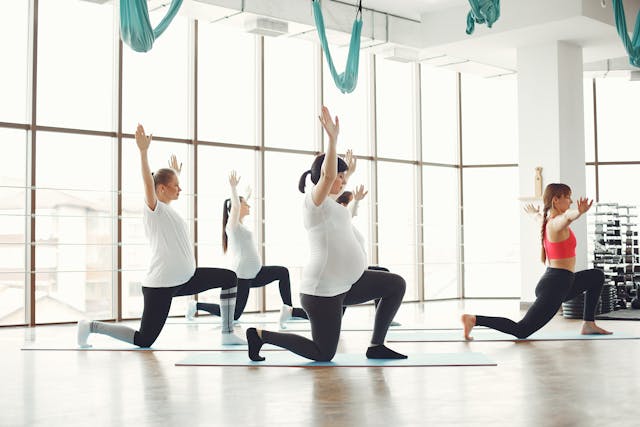Table of Contents
Introduction
Finding out what you’re expecting is one of the most thrilling experiences in life. Along with the excitement comes the responsibility of taking care of both your health and your baby’s well-being. One highly recommended practice for expectant mothers is prenatal yoga. This form of yoga offers numerous benefits, helping you to stay fit, relax, and prepare for childbirth. But how do you find the right prenatal yoga classes near you? Let’s dive in!
What is Prenatal Yoga?
Definition and Overview
Prenatal yoga is a type of yoga specifically designed for pregnant women. It focuses on poses that accommodate a growing belly and provide the strength and flexibility needed for childbirth. Unlike regular yoga, prenatal yoga emphasizes gentle stretching, breathing techniques, and relaxation.
Difference from Regular Yoga
While regular yoga can be intense and include poses that are not suitable during pregnancy, prenatal yoga adapts these practices to ensure the safety and comfort of both mother and baby. It avoids poses that put pressure on the abdomen and includes modifications to traditional poses.
Benefits of Prenatal Yoga
Prenatal yoga offers numerous benefits for expectant mothers, both physically and emotionally. Here are some of the key advantages:
Physical Benefits
- Improved Flexibility and Strength: Prenatal yoga helps in stretching and strengthening muscles, which can alleviate the physical stress of carrying extra weight.
- Reduced Back Pain: Specific poses can relieve the back pain often experienced during pregnancy.
- Better Sleep: Regular practice can improve sleep patterns by reducing physical discomfort and stress.
- Enhanced Circulation: Yoga promotes better blood circulation, which can help reduce swelling and inflammation.
- Easier Labor and Delivery: The breathing techniques and physical stamina built through yoga can make labor and delivery more manageable.
Emotional Benefits
- Stress Reduction: The meditative aspects of yoga help in calming the mind and reducing anxiety.
- Improved Mood: Yoga promotes the release of endorphins, which can improve mood and overall sense of well-being.
- Connection with Baby: Prenatal yoga encourages bonding with the unborn baby through mindfulness and focused breathing.
Social Benefits
- Community Support: Joining a prenatal yoga class provides an opportunity to meet and connect with other expectant mothers, creating a support network.
- Shared Experiences: Engaging with others who are going through similar experiences can provide emotional comfort and practical advice.
Preparing for Motherhood
- Breathing Techniques: Learning proper breathing techniques can help during labor and in managing stress postpartum.
- Awareness and Mindfulness: Prenatal yoga fosters a sense of mindfulness and body awareness, which is beneficial during pregnancy and beyond.
Incorporating prenatal yoga into a pregnancy routine can lead to a healthier, more comfortable pregnancy and a positive childbirth experience.
Finding Prenatal Yoga Classes Near You
Finding prenatal yoga classes near you involves a few steps to ensure you locate the right class that meets your needs. Here’s how you can go about it:
Steps to Find Prenatal Yoga Classes
- Search Online:
- Google Search: Use search terms like “prenatal yoga classes near me” or “prenatal yoga [butterbean.uk].”
- Yoga Studio Websites: Many yoga studios list their class schedules and descriptions online.
- If you’re interested in online classes, our guide on Free Online Yoga Classes can help you get started.
- Yoga Apps: Apps like Mindbody and ClassPass can help you find local classes and read reviews.
- Check Community Centers:
- Local community centers or recreational facilities often offer prenatal yoga classes.
- Libraries and community bulletin boards may also have information on local classes.
- Ask for Recommendations:
- Healthcare Providers: Ask your OB-GYN, midwife, or doula for recommendations.
- Friends and Family: Seek advice from friends, family, or colleagues who have attended prenatal yoga classes.
- Social Media and Online Communities:
- Join local parenting or pregnancy groups on platforms like Facebook. These groups often share information about prenatal activities, including yoga.
- Follow local yoga studios on Instagram or Facebook for updates on their prenatal class offerings.
- Visit Yoga Studios:
- Stop by local yoga studios to inquire directly about prenatal classes. Speaking with instructors can give you a feel for the class environment and teaching style.
- Hospital Programs:
- Some hospitals offer prenatal yoga classes as part of their prenatal care programs. Check with your local hospital to see if they have any offerings.
Factors to Consider
- Instructor Credentials: Ensure the instructor is certified and experienced in teaching prenatal yoga.
- Class Size: Smaller classes can offer more personalized attention.
- Class Schedule: Find a class that fits your schedule and frequency preference (e.g., weekly or bi-weekly).
- Environment: The class should be held in a comfortable, welcoming environment with appropriate props and amenities.
Learn about the benefits of different yoga practices in Creating a Yoga Practice: A Comprehensive Guide.

Qualities to Look for in a Prenatal Yoga Instructor
Choosing the right prenatal yoga instructor is crucial for ensuring a safe and beneficial experience during your pregnancy. Here are some key qualities to look for:
Certification and Experience
- Proper Certification:
- The instructor should be certified in prenatal yoga. Look for credentials from reputable organizations such as Yoga Alliance or similar accrediting bodies.
- Experience:
- An experienced instructor who has taught prenatal yoga classes for several years will be more knowledgeable about the unique needs of pregnant women.
Knowledge and Understanding
- Anatomical Knowledge:
- The instructor should have a solid understanding of prenatal anatomy and the changes a woman’s body undergoes during pregnancy.
- Awareness of Pregnancy Stages:
- They should be familiar with the different stages of pregnancy and know which poses and modifications are appropriate for each trimester.
Teaching Style
- Clear Communication:
- The instructor should be able to give clear, easy-to-follow instructions and explain the benefits and risks of each pose.
- Adaptability:
- They should be able to adapt poses and provide modifications to suit individual needs and limitations.
- Patience and Empathy:
- A good instructor will be patient, empathetic, and supportive, creating a safe and comfortable environment for all participants.
Personal Qualities
- Calm and Reassuring Presence:
- The instructor should have a calming and reassuring presence, helping to reduce anxiety and promote relaxation.
- Approachable and Friendly:
- They should be approachable, making it easy for students to ask questions and express concerns.
- Encouraging:
- A supportive and encouraging instructor helps build confidence and a positive outlook towards pregnancy and childbirth.
Safety and Care
- Focus on Safety:
- The instructor should prioritize safety, ensuring that all movements and poses are performed correctly to avoid injury.
- Attention to Individual Needs:
- They should pay attention to each participant’s individual needs and provide personalized guidance as required.
Environment and Class Structure
- Comfortable and Welcoming Environment:
- The class environment should be comfortable, clean, and welcoming, with appropriate props and equipment.
- Structured Class Plan:
- Classes should have a well-structured plan that includes a balance of stretching, strengthening, and relaxation exercises.
- Integration of Breathing Techniques:
- The instructor should incorporate breathing techniques that help in managing stress and preparing for labor.
Popular Prenatal Yoga Poses
Cat-Cow Stretch
This pose helps relieve back pain and improves spinal flexibility. It’s a gentle way to start your practice.
Warrior II Pose
Strengthening the legs and improving balance, Warrior II is a great pose for building endurance.
Child’s Pose
This restorative pose helps relax the back and hips, providing a moment of rest during your practice.
Prenatal Yoga for Different Stages of Pregnancy
Prenatal yoga can be highly beneficial throughout pregnancy, but it’s important to adapt your practice to the different stages of pregnancy to ensure safety and maximize benefits. Here’s a guide on how to approach prenatal yoga during each trimester:
First Trimester (Weeks 1-12)
Focus:
- Establishing a Foundation:
- Focus on gentle stretching and basic poses to create a strong foundation.
- Mindfulness and Relaxation:
- Incorporate breathing exercises and meditation to reduce stress and anxiety.
Recommended Poses:
- Cat-Cow Pose (Marjaryasana-Bitilasana):
- Helps to maintain flexibility in the spine and relieve back tension.
- Mountain Pose (Tadasana):
- Enhances balance and posture.
- Seated Forward Bend (Paschimottanasana):
- Gentle stretch for the back and legs, promoting relaxation.
Modifications:
- Avoid poses that involve deep twists or excessive abdominal compression.
- Focus on maintaining balance and avoiding poses that feel uncomfortable.
Second Trimester (Weeks 13-26)
Focus:
- Strength and Stability:
- Work on building strength and stability, especially in the legs and pelvic area.
- Pelvic Floor Exercises:
- Incorporate exercises to strengthen the pelvic floor muscles.
Recommended Poses:
- Warrior II (Virabhadrasana II):
- Strengthens the legs and improves stamina.
- Triangle Pose (Trikonasana):
- Stretches the sides of the body and helps with balance.
- Bridge Pose (Setu Bandhasana):
- Strengthens the back and glutes and opens the chest and hips.
Modifications:
- Use props like blocks and straps to aid in poses.
- Avoid lying flat on your back for extended periods to prevent reduced blood flow.
Third Trimester (Weeks 27-40)
Focus:
- Preparation for Labor:
- Emphasize poses that open the hips and promote relaxation.
- Breathing Techniques:
- Practice deep breathing techniques to prepare for labor and delivery.
Recommended Poses:
- Goddess Pose (Utkata Konasana):
- Opens the hips and strengthens the legs.
- Child’s Pose (Balasana):
- Provides gentle relaxation and relief from back pain.
- Squat Pose (Malasana):
- Opens the pelvic area and strengthens the lower body.
Modifications:
- Use a wall or chair for support during standing poses.
- Avoid poses that put pressure on the belly or require lying on the stomach.
General Tips for All Trimesters
- Listen to Your Body:
- Always listen to your body and modify poses as needed. If something feels uncomfortable or painful, stop immediately.
- Stay Hydrated:
- Keep yourself well-hydrated before, during, and after yoga sessions.
- Avoid Overexertion:
- Prenatal yoga should be gentle and relaxing, not overly strenuous. Avoid pushing yourself too hard.
- Consult Your Healthcare Provider:
- Before starting any prenatal yoga practice, consult with your healthcare provider to ensure it’s safe for you and your baby.
Common Myths about Prenatal Yoga
Prenatal yoga is widely recognized for its benefits, but there are several myths and misconceptions that can deter expectant mothers from participating. Here are some common myths about prenatal yoga and the truths behind them:
Myth 1: Prenatal Yoga is Too Gentle to Be Effective
Truth: While prenatal yoga is gentle, it is specifically designed to meet the needs of pregnant women. It effectively enhances strength, flexibility, and relaxation, which are crucial for managing the physical and emotional changes during pregnancy. Prenatal yoga focuses on safe, modified poses that offer substantial benefits without the risks associated with more intense workouts.
Myth 2: Yoga is Only for the Flexible
Truth: Flexibility is not a prerequisite for practicing yoga. Prenatal yoga welcomes all levels of flexibility and fitness. The practice emphasizes gentle stretching and gradual improvement, making it accessible to everyone. Props like blocks, straps, and bolsters can help modify poses to accommodate all levels of flexibility.
Myth 3: Prenatal Yoga Can Induce Labor Prematurely
Truth: Properly guided prenatal yoga does not induce premature labor. The practice includes safe, gentle movements that support the body’s natural processes. Instructors are trained to avoid any poses or techniques that could stimulate early labor, ensuring that the practice is safe throughout the pregnancy.
Myth 4: You Can’t Start Prenatal Yoga if You Didn’t Do Yoga Before Pregnancy
Truth: Prenatal yoga is suitable for both beginners and experienced practitioners. Many women start yoga for the first time during pregnancy. Prenatal yoga classes are tailored to the unique needs of pregnant women, making them an ideal starting point for those new to yoga.
Myth 5: Prenatal Yoga is Only About Stretching
Truth: While stretching is a component, prenatal yoga encompasses much more. It includes strength-building exercises, breathing techniques, meditation, and relaxation practices. These elements help manage stress, improve sleep, and prepare the body and mind for labor and delivery.
Myth 6: It’s Dangerous to Do Yoga During Pregnancy
Truth: When practiced correctly and under the guidance of a certified instructor, prenatal yoga is safe and beneficial. Instructors are trained to modify poses to accommodate pregnancy and to ensure that all movements are safe. It’s important to inform your instructor about your pregnancy and any specific concerns you might have.
Myth 7: All Yoga Classes are Suitable for Pregnant Women
Truth: Not all yoga classes are appropriate for pregnant women. Prenatal yoga classes are specifically designed to address the unique needs and safety concerns of pregnancy. It’s essential to attend classes that are specifically labeled as prenatal yoga to ensure the safety and appropriateness of the practice.
Myth 8: You Have to Avoid All Abdominal Exercises During Pregnancy
Truth: While certain abdominal exercises are not recommended during pregnancy, prenatal yoga includes safe, modified core strengthening exercises. These exercises help support the growing belly and improve overall stability and posture. It’s about finding the right balance and modifications.
FAQs
When Should You Start Prenatal Yoga?
You can start prenatal yoga at any time during your pregnancy, but many women find it beneficial to begin early in their pregnancy. Here’s a guideline for when to start:
First Trimester (Weeks 1-12):
It’s generally safe to start prenatal yoga as soon as you feel comfortable, typically after the first few weeks of pregnancy. However, some women prefer to wait until after the first trimester when the risk of miscarriage decreases.
Second Trimester (Weeks 13-26):
This is often considered the ideal time to start prenatal yoga. Morning sickness usually subsides, energy levels increase, and it’s a good time to build strength and flexibility as your body starts to change more visibly.
Third Trimester (Weeks 27-40):
It’s never too late to start prenatal yoga, even in the third trimester. Focus on gentle, supportive poses that help with relaxation and preparation for labor.
Is Prenatal Yoga Effective?
Yes, prenatal yoga is highly effective and offers numerous benefits, including:
Physical Benefits:
Improves flexibility, strength, and endurance of muscles needed for childbirth.
Reduces back pain, nausea, headaches, and shortness of breath.
Enhances circulation and helps maintain a healthy weight.
Emotional Benefits:
Reduces stress and anxiety through relaxation techniques.
Promotes better sleep by reducing physical discomfort and calming the mind.
Encourages a sense of well-being and emotional balance.
Labor and Delivery Benefits:
Prepares the body for labor through breathing exercises and strengthening muscles.
Improves pain management during labor by teaching effective breathing and relaxation techniques.
Which Yoga is Best During Pregnancy?
Prenatal yoga is specifically designed for pregnant women, making it the best type of yoga to practice during pregnancy. Here are some key elements and poses that are particularly beneficial:
Key Elements of Prenatal Yoga:
Breathing (Pranayama): Focused breathing techniques to help manage shortness of breath and anxiety.
Gentle Stretching: Gentle movements to increase flexibility and relieve muscle tension.
Postures (Asanas): Modified yoga poses to accommodate the changing body and ensure safety.
Cool Down and Relaxation: Techniques to cool down the body and promote relaxation.
Recommended Poses:
Cat-Cow Pose (Marjaryasana-Bitilasana): Helps relieve back pain and maintain spinal flexibility.
Child’s Pose (Balasana): Provides gentle relaxation and stretch for the lower back.
Warrior II (Virabhadrasana II): Strengthens the legs and opens the hips.
Goddess Pose (Utkata Konasana): Opens the hips and strengthens the legs, preparing the body for labor.
Squat Pose (Malasana): Opens the pelvic area and strengthens the lower body, useful for labor preparation.
Conclusion
Prenatal yoga offers a wealth of benefits for both mother and baby. From physical strength to emotional well-being, it’s a holistic approach to a healthier pregnancy. So why wait? Start your journey with prenatal yoga today and experience the transformative power it brings to this beautiful phase of life.







